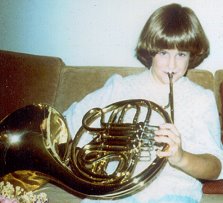In case you all were wondering about the title of my blog, it's from a Far Side Cartoon. I just love it. There's no hidden meaning in the fact that my blog name comes from this cartoon. I simply find it hilarious. Here it is:
So much to tell and I haven't written in so long, I feel blocked, and for me, who always has a lot to say, that's something. Thank god I type with 100% accuracy at 95 wpm or I'd never leave the computer (some of you probably already think that, I'm sure). I'm sure once I get writing here today, I won't be able to stop and you poor blog donkeys will have to wade through paragraph after paragraph of my endless drivel. Oh well. I shall take this opportunity to remind you that you visited this link on your own volition!
This week has been a moderately fun one at work. We did a sort of hodgepodge concert of a bunch of Spanish-influenced tunes: Bolero, Alborado del Graziozo, and a concerto for guitar and violin by Assad that I did not play on.
The Alborado was fun. We had some challenging bits that gave us something to do, namely in the realm of triple tonguing. For those of you incredibly fortunate souls who don't know what triple tonguing is, it's a technique by which wind players create multiple syllables with the tongue to achieve rapid repetitive tonguing.
Single tonguing, which is just using the front (or tip) of one's tongue uses the syllable "Tuh" or "Duh". When you multiple tongue (as in double or triple tonguing), you also employ the syllable "Kuh" or "Guh" with the back of your tongue. Double tonguing is used when you have rapid groups of two: Tuh-Kuh, Tuh-Kuh, Tuh-Kuh;and triple tonguing when you have rapid groups of three notes: Tuh-Tuh-Kuh, Tuh-Tuh-Kuh, Tuh-Tuh-Kuh.
Okay, I'm sure that's much more information than you ever wanted or certainly needed to know. Anyway, so the Alborado had lots of triple tonguing and so that was exciting.
Bolero, on the other hand, was both exciting and torturously boring. The exciting part is that the piece is one huge crescendo from the beginning to end, repeating the same tune over and and over over again until the loud climax at the end. The torturously boring part is that the piece is one huge crescendo from the beginning to end, repeating the same tune over and and over over again until the loud climax at the end. Everyone in the orchestra at some point plays the ostinato (or underlying rhythm that's repeated over and over again) that goes a little something like this:
DIT, dididiDIT, dididiDIT, DIT.
DIT, dididiDIT, dididi dididi dididi.
Multiply that several hundred times, and you've got the rhythmic structure of Bolero - or as we brass players have not-so-affectionately termed it, "BLARE-O".
If you're dying to know what it sounds like, you can hear it by clicking here (make sure you turn up your speakers because the clip is of the beginning, which is really soft).
Anyway, it's no wonder that the word "ostinato" means "stubborn" in Italian (note the resemblance to the word "obstinate"). It is indeed a very stubborn rhythm and it's really very obnoxious after a while. Some audience member told me after the concert last night that he really appreciated the horns keeping up the repeated notes so well, which of course made my day. I told him so and thanked him for his keen observation and for noticing.
One thing they are doing that I hate is adding special lighting effects. Just in case you're a complete idiot who can't tell that the piece is climaxing at the end, they flash these big red bright lights on the back of the shell in time with the music. If I was in the audience, I would find that very distracting from appreciating what the orchestra was trying to do musically.
As far as the sexual implications of Bolero, I'm sorry, but I just don't see it. If sex was that boring and repetitive, no one with half a brain cell would do it and the population would die out altogether. Certainly if it was as sloppy, messy and gross as the end of Bolero sounds with its smeary trombone glisses and discordant gong crashes, I'm quite sure I would wear a raincoat and rubber boots to bed every night just as a precaution.
Having said that, I do for some reason enjoy the end of Bolero. There is something neat about the slow, repetitive build-up that really sets up the excitement for the almost grotesque ending. If you just fast forwarded to the end of it without having to sit patiently through the soft solo versions of the theme at the beginning, you wouldn't get the same thrill. Although the thought has crossed my mind that the reason I like the ending so much is really just relief that the piece is over and I don't have to play any more dididi-dididi-dididi's. {sigh} That may very well be the real reason.
Nadja Salerno-Sonnenberg is the guest violinist this weekend. She plays with more subtlety, nuance, and deep inflection than I've ever heard any violinist use, ever. Listening to her is really a treat. She can play just one note, and in that note, make you feel at least 3 different things and can transport you to another place. Her subtleties were absolutely exquisite. As I said, I didn't play on the Assad concerto she did, but I did play a whopping two notes on the top-40 classical hit Meditation from Thais by Massenet (listen here, you'll totally recognize it). This is a piece that can easily sound cloying and sappy (you'd really have to work to have it not sound that way, actually), but the way she played it added such depth and intimacy that the piece probably doesn't even deserve. I would have loved to have heard her do a solo piece as an encore. Who knows - tonight is Saturday, after all!
We also did Debussy's Claire de Lune, arranged for orchestra. This is another top-4o classical hit and I'm not quite sure what it has to do with "Latin Passion", which is what this weekend's concerts have been dubbed. I much prefer the original piano version, which my best friend Karinia played so beautifully at our wedding.







No comments:
Post a Comment